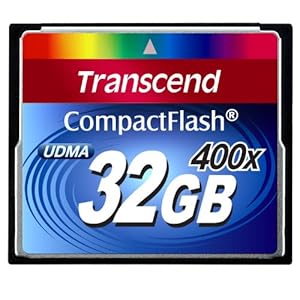Transcend 32 GB Compact Flash Card 400X (Blue)
Posted by Free Vista Theme XP
» Wednesday, April 4, 2012

Product Details
- Product Dimensions: 1.7 x 1.4 x 0.1 inches ; 1.1 ounces
- Shipping Weight: 4 ounces (View shipping rates and policies)
- Shipping: This item is also available for shipping to select countries outside the U.S.
- ASIN: B002WE4H8I
- Item model number: TS32GCF400
By : Transcend
Price :
$62.96You Save :
$25.98 (29%)
Product Description
Dedicated to fulfill the demanding requirements of performance-conscious photographers, Transcend proudly releases its Extreme 400X CompactFlash cards. With its amazing performance and huge capacity of up to 64 GB, the Transcend 400X CompactFlash memory card allows the professional photographers and enthusiasts to get the most from your digital single lens reflex (DSLR) camera. Users are guaranteed to make consecutive shooting and non-stop video recording and share their digital artwork with the world!
Technical Details
- Read_90 MB/sec(Max), Write_60 MB/sec (Max)
- Support high-end DSLR
- Ultra-fast 400X performance with four-channel support
- Low power consumption
- Lifetime Warranty
Customer Reviews
If you need a fast high capacity CF card at a reasonable price, Transcend's 32GB (Blue) card is a good choice. This 400X card has a maximum read speed of 90MB/sec, and more importantly a write speed of 60MB/sec.
Shooting photos at maximum quality (saving both JPEG and RAW files), I was looking for a faster card for my Canon 7D an 18 megapixel digital SLR. The results using this card are excellent. The 7D has a burst rate of 8 frames per second, and the camera's buffer is large enough, so that you can easily shoot a 10 or 15 shot burst, without the camera locking up. Of course it takes some time for the camera to write to the card after such a burst, so I did a quick comparison using the Transcend 400x card, a Kingston 266x card, and a Transcend 133x card. I took a 10 shot burst, and then measured the time between the last shot and when the frame counter in the display stopped blinking, roughly indicating that data had finished writing to the card. The results of this crude test were, that the 400x card took 5 seconds, the 266x card 15 seconds, and the 133x card 25 seconds. Increasing to a 15 shot burst, the results were, 7.5 seconds for the 400x card, 22 seconds for the 266x card, and 37 seconds for the 133x card.
My tests are informal, and your results may vary, but these findings may provide some rough indication of the performance the card is capable of. I have used it on a couple of shoots, and haven't experienced any delays, while the camera writes to the card.
I have heard various professional photographers recommend using smaller cards, usually 8GB, rather than 16GB or 32GB cards. The thinking is that cards will eventually fail, and they feel more comfortable having their images from a particular shoot (usually a wedding), on several cards rather than on one card. That way if a card happens to fail, they will not lose all the images from that one event. While that kind of approach may make sense to someone shooting a wedding, I like having a card with enough capacity to shoot an entire event, and not have to worry about running out of memory or changing and keeping track of cards. Using a 7D, a 32GB card is good for about 950 images, which is great for photo shoots with models, shooting on a trip, or an extended event, like a basketball tournament, or runners in a marathon.
With camera file sizes increasing, "large capacity" is a relative term. So that 8GB card that was "huge" a couple of years ago, is kind of "small" today. Someday soon, the same will probably be true of even 32GB cards. Transcend's new 64GB (Blue) compact flash card may seem excessive, but digital SLR's being capable of shooting high definition video, has raised memory requirements to a new level. And finally, while using bigger cards may be more "risky" for some, for others they are more convenient, and they are generally less expensive per GB.
Due to good performance and reliability over several years, Transcend is a brand that I have come to trust for both compact flash and SD memory cards. Transcend cards are usually less expensive than equivalent cards by SanDisk or Lexar. They have a lifetime warranty, but fortunately I haven't had a Transcend card fail yet. If you do happen to get a bad card when buying from Amazon, replacement is usually a fast and hassle free process. This 400x card is fast, and at this time is a very good deal for under $100.
Like another poster, this card also failed on me after one month. I used it in a Canon 5DMk2, taking movies, images. I had an important shoot to do for a friend's family (all gathered from out of town). Everything seemed fine while taking the photos. I was able to review them on the camera, etc.
Got home, took the card out, plugged it into the PC's card reader.
Nothing. The computer didn't even see the card. I put it back into the camera. The camera also said that the card wasn't there, or needed to be formatted.
I tried every recovery program I had to find the card and the files. Nothing worked.
I tried formatting the card in the camera, and the camera wouldn't format it.
This is the last Transcend card I'm buying.
ADS HERE !!!